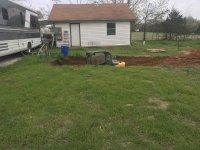There are two kinds of soil here, sandy clay and rock. I was thinkin' I could use the skid steer to start the pad, and when I got down to rock, either rend an excavator or one of those rock hammers for the skid.
Which brings up another question: are the mounts for the various implements pretty much standard? So I could go to the local rental place and check out one of those hammers no matter if I end up with a Volvo, Takeuchie, Bobcat, or whatever brand?
Thanks again for sharing your experience!
Almost all of the attachments will work on any skid steer. Some of the older ones need a little adjustment (cutting torch). But for the most part you can rent a hammer and install it on your machine, performance depends upon your auxiliary hydraulic output. So you would want to have the most machine you can afford. Be a bugger bear to rent a machine needing 25 gpm and all you’re putting is out 11.
However, however the size of a budget or three, when you rent that machine you are corrupting your machine’s oil with whatever and whoever abused said attachment in the past. I’m sure there has to be a process where you can rest something and be confident that the oil in the attachment is clean. This would be a double concern if attachment was something with high gpm requirements. The last guy who rented it had his pumps going south and shedding material and now you have that in your machine. The same concern would be about buying something like a hammer used.
When I was looking for my skid steer I was reintroduced to the reality of skid steers. Most of them are operated by wild things who don’t give a hoot because they belong to someone else. Every now and then you will find an owner operator who has taken care of it but then the price reflects that too.
There are some really good articles out there on the advantages of track vs tires. As Ron mentioned, tracks can have issues in rocks when a rock gets in the mechanism and you lose a track. But in soft sand or mud tires are not competition for tracks. But then tracks tear up turf more than tires. Tracks don’t like hard surfaces, tires don’t either but they’re cheaper to replace. Tires allow a hot dog to wheelie and act the fool, guilty as charged while tracks don’t.
Two kinds of lift, vertical, you lift like a forklift, straight up and down, really nice when loading and unloading with forks or digging post holes. Radial lift, you’re lifting in an arc like with your tractor’s FEL. I’m sure you’ve lifted something with the tractor just over capacity and it was okay until you got it about hood high and then you were going end over apple cart with the rear wheels off the ground, radial lift, hood high, furtherest reach of arc. My first lesson of that was unloading some pipe with the skid steer right after I got it. Bundle of pipe top of the load on the truck. I was able to lift it by tilting back it was so high. I backed up lowering it down and then instantly radial lift kicked in and I was almost bounced out of the tractor as load crashed to the ground. But radial lift gives you best digging mechanical leverage. It is also simpler, fewer arms and pins to maintain.
Once again, for such a pad build I would consider a small dozer. Rent it for a week, keep in mind a weeks is 40 machine hours. They’ll deliver it, pick it up, and it’s as easy to use as the skid steer for first time users. They have joy stick controls and are designed for easy mastery. Beware of renting an excavator. You will fall in love and your life will never be the same. I still get giddy about the time I got to play on a Cat 375, quiet power, unbelievable power.
Here I have iron rock about three foot down for a layer. I use the touch bucket and work at it because I know it is just a layer and it is very brittle, when it breaks it looks like cast iron. The same thing with using the augers, I let it work because I know the material is brittle and will shatter and break up.






